Lenovo M910Q User Manual
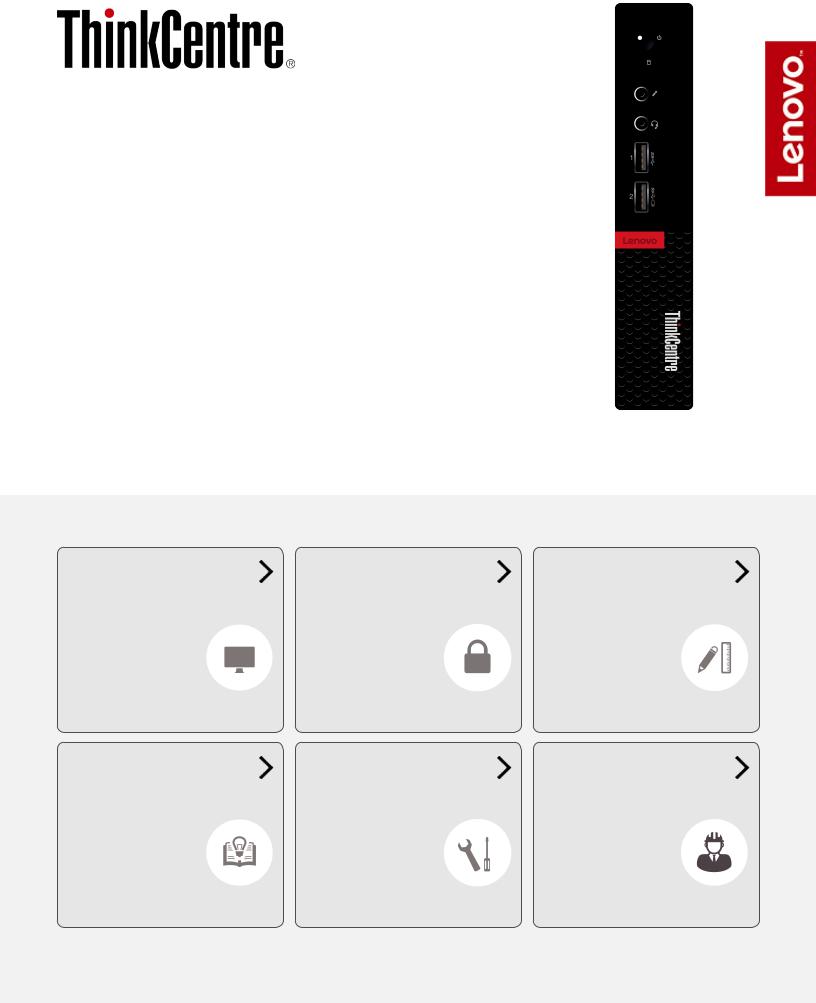
M910q
User Guide and
Hardware Maintenance Manual
Machine Type (MT):
10MU, 10MV, 10MW, 10MX, 10QN
Energy Star MT:
10MU, 10MV, 10MW, 10MX, 10QN
Overview |
Computer locks |
Specifications |
Locations of indicators, |
Locking devices for |
Specifications of your |
connectors, and |
your computer |
computer |
controls provided on |
|
|
your computer |
|
|
Replaceable parts |
Replacing CRUs |
Replacing FRUs |
Locations of the |
Replacing instructions |
Replacing instructions |
replaceable parts on |
for customer- |
for field-replaceable |
your computer |
replaceable units |
units (FRUs) (for |
|
(CRUs) |
technicians only) |

Contents |
|
Overview......................................... |
3 |
Front view....................................................................... |
3 |
Rear view........................................................................ |
4 |
System board................................................................. |
6 |
Machine type and model label................................... |
7 |
I/O box............................................. |
8 |
Overview......................................................................... |
8 |
Using the I/O box.......................................................... |
9 |
Computer locks............................. |
10 |
Attaching a Kensington-style cable lock................ |
10 |
Specifications............................... |
11 |
Replacing hardware...................... |
12 |
Before replacing hardware........................................ |
12 |
Handling static-sensitive devices............................ |
12 |
Knowing replaceable parts........................................ |
13 |
Customer-Replaceable Units (CRUs)........................... |
13 |
Field-Replaceable Units (FRUs).................................... |
13 |
CRUs and FRUs locations.............................................. |
14 |
Replacing CRUs............................. |
17 |
Before replacing CRUs............................................... |
17 |
Replacing the keyboard or wireless keyboard....... |
19 |
Replacing the keyboard................................................... |
19 |
Replacing the wireless keyboard................................... |
19 |
Replacing the mouse or wireless mouse............... |
20 |
Replacing the mouse....................................................... |
20 |
Replacing the wireless mouse....................................... |
20 |
Replacing the power adapter.................................... |
22 |
Replacing the vertical stand..................................... |
23 |
Replacing the VESA mount bracket........................ |
24 |
Replacing the external optical drive box................ |
25 |
Replacing the external I/O box................................. |
26 |
Replacing the power adapter bracket..................... |
27 |
Removing the computer cover and dust shield.... |
28 |
Replacing the storage drive...................................... |
29 |
Replacing the internal speaker................................. |
30 |
Replacing the system fan.......................................... |
31 |
Replacing the Wi-Fi card........................................... |
32 |
Replacing the bottom cover...................................... |
35 |
Replacing the memory module................................ |
36 |
Replacing the M.2 storage drive.............................. |
37 |
Completing the parts replacement.......................... |
38 |
Replacing FRUs............................. |
39 |
Before replacing FRUs............................................... |
39 |
Replacing the illuminated red dot cable................. |
41 |
Replacing the advanced speaker............................. |
42 |
Replacing the Wi-Fi antennas.................................. |
43 |
Replacing the front Wi-Fi antenna................................ |
43 |
Replacing the rear Wi-Fi antenna.................................. |
44 |
Replacing the storage drive cable........................... |
46 |
Replacing the heat sink.............................................. |
47 |
Replacing the microprocessor................................. |
48 |
Replacing the coin-cell battery................................ |
50 |
Replacing the antenna bracket, system board, and |
|
chassis.......................................................................... |
52 |
Notices & Trademarks................... |
54 |
Notices.......................................................................... |
54 |
Trademarks.................................................................. |
55 |
|
2 |
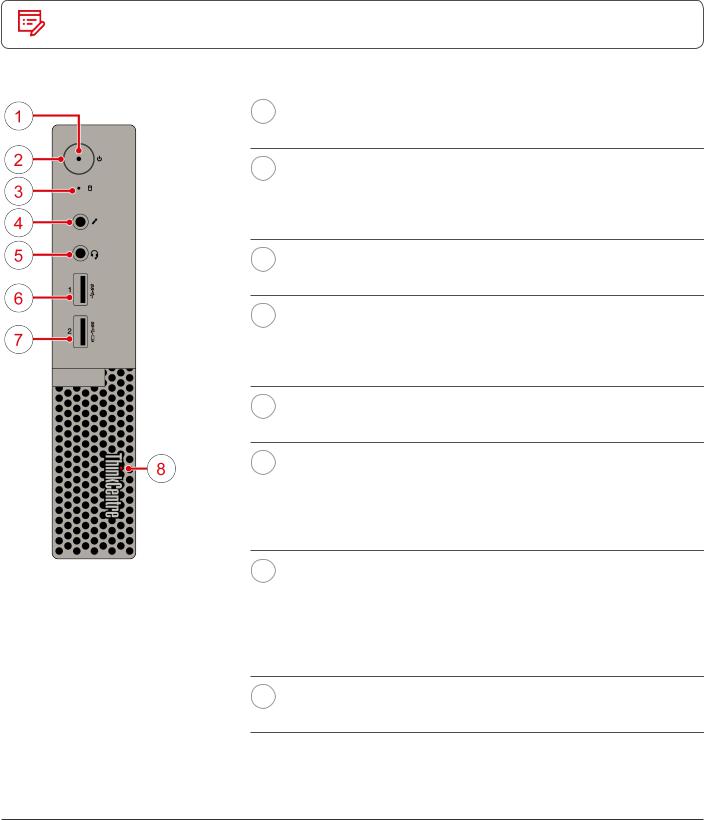
Overview
Front view
Note |
Your computer model might look slightly different from the illustration. |
1 Power indicator
This indicator is on when the computer is on.
2 Power button
Used to turn on your computer. When you cannot shut down the computer from the operating system, press and hold the power button for four or more seconds to turn off the computer.
3 Storage drive status indicator
This indicator is on when the storage drive is in use.
4 Microphone connector
Used to connect a microphone to your computer. You can use the microphone to record sounds or interact with the computer using speech-recognition software.
5 Headset connector
Used to connect a headset or headphones to your computer.
6 USB 3.0 connector
Used to connect a USB-compatible device, such as a USB keyboard, mouse, scanner, printer, or personal digital assistant (PDA). For optimal data transfer, connect a USB 3.0 device to a USB 3.0 connector instead of a USB 2.0 connector.
7 Always On USB 3.0 connector
Used to connect a device that requires a USB 2.0 or USB 3.0 connection, such as a keyboard, a mouse, a scanner, a printer, or a personal digital assistant (PDA). With the power adapter connected, you can charge the automatically detected device even when the computer is in hibernation mode or turned off.
8 Illuminated red dot
This indicator is on when the computer is powered on.
Overview |
3 |

Rear view
Note
Your computer model might look slightly different from the illustration.
9 Optional connector 1
Depending on the computer model, the connector might vary.
10 Optional connector 2
Depending on the computer model, the connector might vary.
11 |
Security-lock slot |
Used to secure a Kensington-style cable lock.
12 Wi-Fi antenna slot
Used to install the rear Wi-Fi antenna cable connector that is available only on some models. The rear Wi-Fi antenna is installed on the rear Wi-Fi antenna cable connector.
13 Ethernet connector
Used to connect an Ethernet cable for network access.
14 USB 3.0 connectors (2)
Used to connect a device that requires a USB 2.0 or USB 3.0 connection.
15 USB 3.0 connector
Used to connect a device that requires a USB 2.0 or USB 3.0 connection.
Note |
The USB 3.0 connector supports the |
|
smart power on feature that enables |
||
|
||
|
you to turn on the computer or wake |
|
|
it up from S4 hibernation mode by |
|
|
pressing Alt+P on the keyboard. You |
|
|
can enable or disable the smart power |
|
|
on feature from the Setup Utility |
|
|
program. For detailed information, see |
|
|
Important Product Information Guide. |
|
|
|
Overview |
4 |
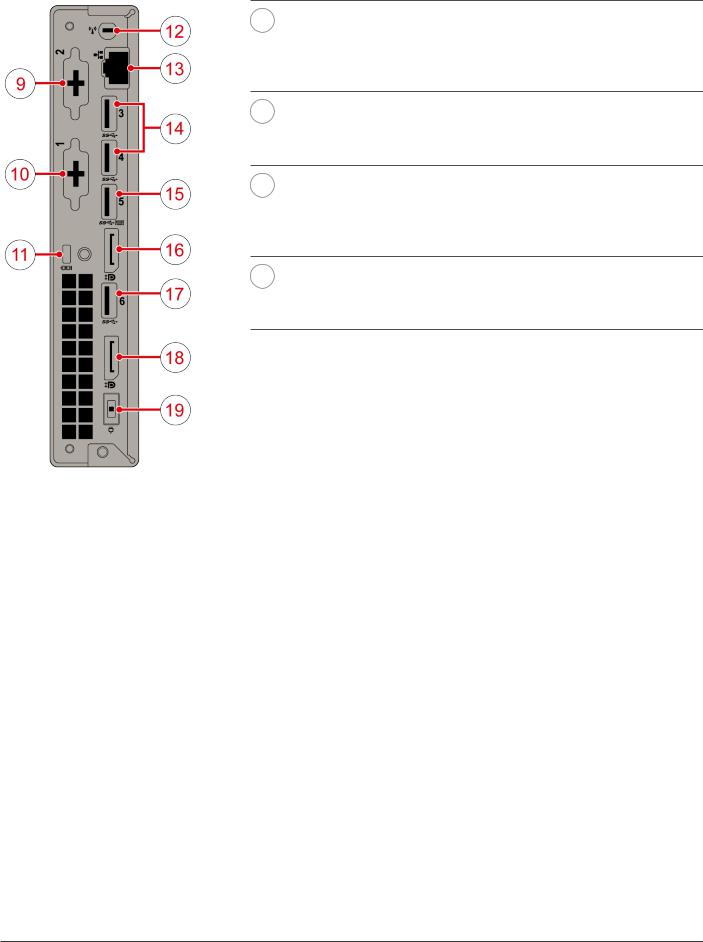
16 DisplayPort® connector
Used to send or receive audio and video signals. You can attach a compatible audio or video device to this connector, such as a high-performance monitor.
17 USB 3.0 connector
Used to connect a device that requires a USB 2.0 or USB 3.0 connection.
18 |
DisplayPort connector |
Used to send or receive audio and video signals. You can attach a compatible audio or video device to this connector, such as a high-performance monitor.
19 Power adapter connector
Used to connect the power adapter to your computer for power supply.
Overview |
5 |

System board
Note |
See |
|
or |
|
for additional component descriptions. |
Front view |
Rear view |
1 |
Serial connector 1 |
|
|
2 |
Serial connector 2 |
|
|
3 |
USB 3.0 connector |
|
|
4 |
Storage drive fan connector |
|
|
5 |
Microprocessor socket |
|
|
6 |
Coin-cell battery |
|
|
7 |
Illuminated red dot connector |
|
|
8 |
Internal speaker or advanced speaker |
|
connector |
|
|
9 |
System fan connector |
|
|
10 |
SATA storage drive connector |
|
|
11 |
M.2 Wi-Fi card slot |
|
|
12 |
Memory slot (DIMM1) |
|
|
13 |
Memory slot (DIMM2) |
|
|
14 |
M.2 storage drive slot |
|
|
Overview |
6 |
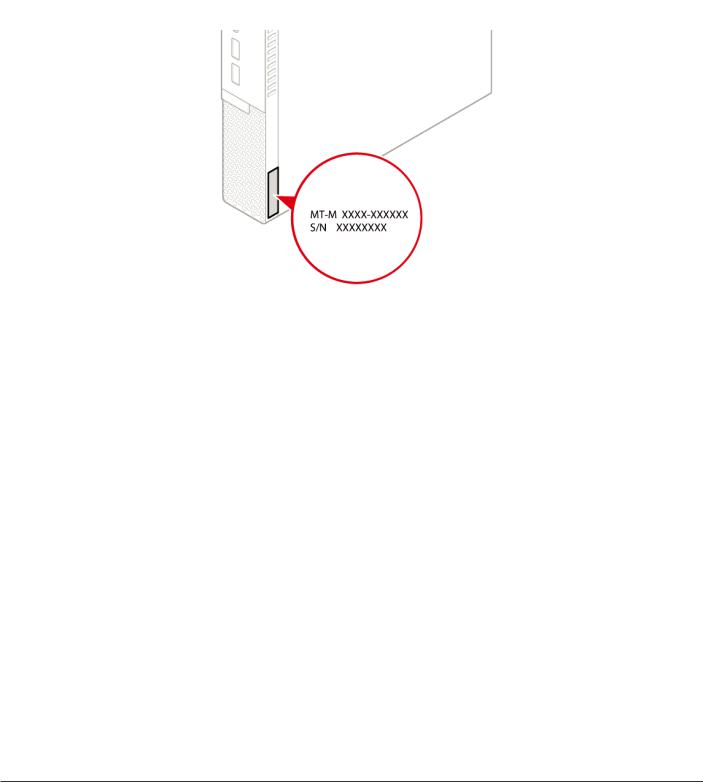
Machine type and model label
The machine type and model label identifies your computer. When you contact Lenovo for help, the machine type and model information helps support technicians to identify your computer and provide faster service.
The machine type and model label is attached on the side of your computer as shown.
Overview |
7 |
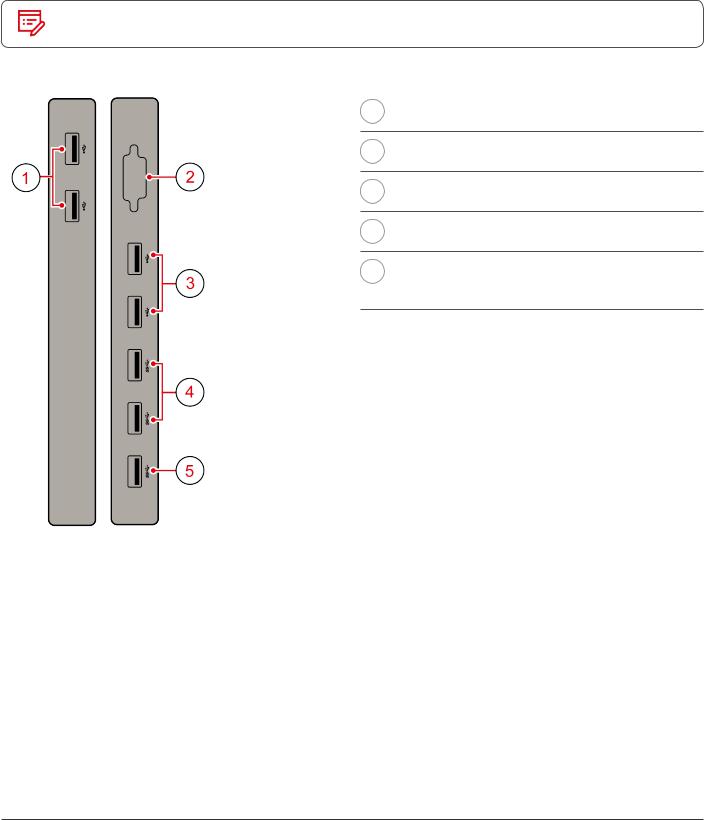
I/O box
Overview
Note |
Depending on your computer model, the I/O box might be optional. |
1 USB 2.0 connectors (2)
2 Serial connector (optional)
3 USB 2.0 connectors (2)
4 USB 3.0 connectors (2)
5 USB 3.0 connector
(for connecting to the computer)
I/O box |
8 |

Using the I/O box
When you use the I/O box with the ThinkCentre tiny computer, note the following:
••The I/O box supports a maximum current rating of 5 A. It is recommended that you connect low-current devices to the I/O box and connect high-current devices directly to the ThinkCentre tiny computer to ensure the best performance of the devices.
••The USB 2.0 connectors and USB 3.0 connectors on the I/O box provide a current of 500 mA and 900 mA current, respectively. When you connect a high-current storage drive to only one USB connector, the system might not recognize the device. You can connect the storage drive to two USB connectors on the I/O box.
••The serial connector does not support hot swapping. Do not connect a device to the connector or remove a device from the connector while the system is running.
••The connectors on the I/O box cannot be enabled or disabled individually. To enable or disable any of the connectors on the I/O box, enable or disable the USB connectors on the rear of the computer.
••The I/O box enables you to wake up the computer from standby mode through operations on devices connected to the I/O box connectors.
I/O box |
9 |
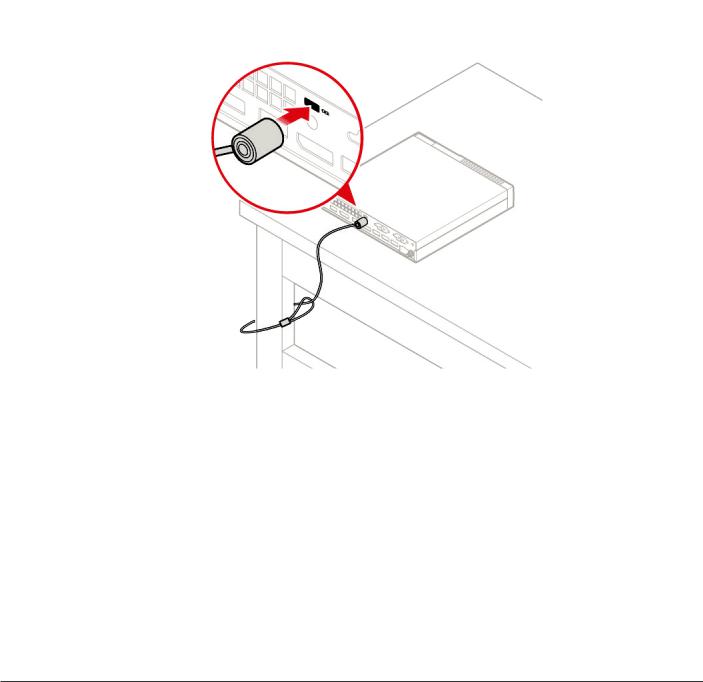
Computer locks
Attaching a Kensington-style cable lock
You can use a Kensington-style cable lock to secure your computer to a desk, table, or other nonpermanent fixture. The cable lock connects to the security-lock slot at the rear of your computer.
Depending on the type selected, the cable lock can be operated with a key or combination. The cable lock also locks the buttons used to open the computer cover. This is the same type of lock used with many notebook computers. You can order such a cable lock directly from Lenovo by searching for Kensington at: http://www.lenovo.com/support.
Computer locks |
10 |

Specifications
Power supply
•• 65 watt automatic voltage-sensing power supply
•• 90 watt automatic voltage-sensing power supply (optional)
Storage drives |
Up to two storage drives |
|
|
Video features |
The integrated graphics card supports the following: |
|
•• DisplayPort connectors |
Audio features
The integrated audio card supports the following:
•• Advanced speaker (optional)
•• Headset connector
•• Internal speaker
•• Microphone connector
Input/Output (I/O) features
•• Audio connectors (headset and microphone)
•• DisplayPort connectors
•• Ethernet connector
•• Serial connectors (optional)
•• USB connectors
Expansion |
•• External I/O box (optional) |
|
•• External optical drive box (optional) |
|
•• Memory slots |
Network features
•• Ethernet LAN
•• Wireless LAN (optional)
•• Bluetooth (optional)
Physical dimensions
•• Width: 35 mm (1.4 inches)
•• Height: 183 mm (7.2 inches)
•• Depth: 179 mm (7.1 inches)
Weight (without the package) •• Maximum configuration as shipped: 1.3 kg (2.9 lb)
Specifications |
11 |

Replacing hardware
Before replacing hardware
 Attention
Attention
Do not open your computer or attempt any repairs before reading the Important Product Information Guide.
Read these notes before replacing hardware:
••Some of the hardware components explained in this manual are optional.
••Use computer components provided only by Lenovo.
••When installing or replacing an option, use the appropriate instructions explained in this manual along with the instructions that come with the option.
••In most areas of the world, Lenovo requires the return of defective CRUs (Customer Replaceable Units). Information about this will come with the CRU or will come a few days after the CRU arrives.
Handling static-sensitive devices
Do not open the static-protective package containing the new component until the defective component has been removed and you are ready to install the new component. Static electricity, although harmless to you, can seriously damage computer components.
When you handle parts and other computer components, take these precautions to avoid static damage:
••Limit your movement. Movement can cause static electricity to build up around you.
••Always handle parts and other computer components carefully. Handle PCI/PCI-Express cards, memory modules, system boards, and microprocessors by the edges. Never touch any exposed circuitry.
••Prevent others from touching the parts and other computer components.
••Touch the static-protective package containing the part to a metal expansion-slot cover or other unpainted metal surface on the computer for at least two seconds. This reduces static electricity from the package and your body before you install or replace a new part.
••When possible, remove the new part from the static-protective package, and install it directly in the computer without setting the part down. When this is not possible, place the static-protective package that the part came in on a smooth, level surface and place the part on the package.
••Do not place the part on the computer cover or other metal surface.
Replacing hardware |
12 |
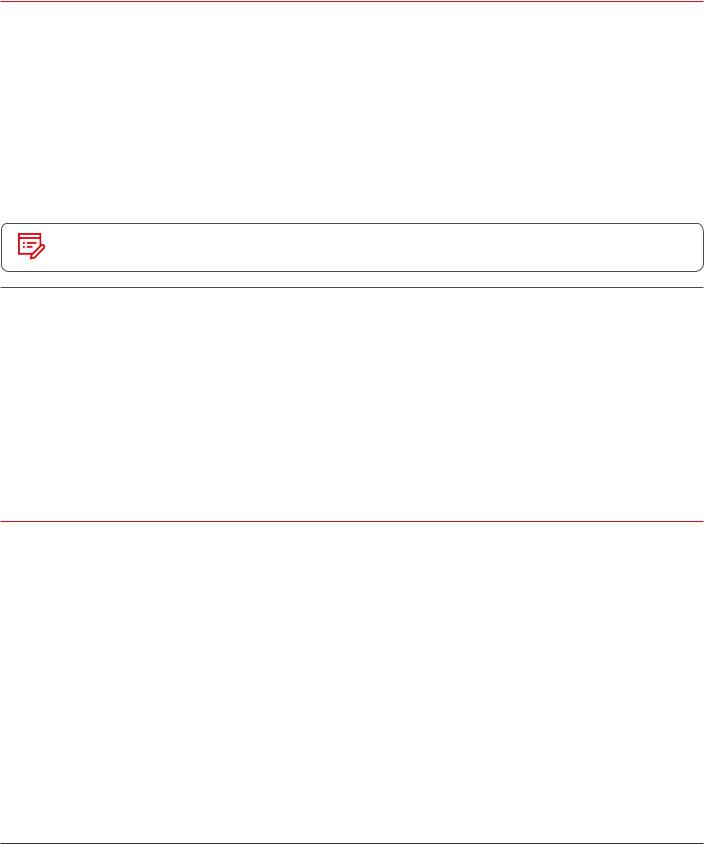
Knowing replaceable parts
Customer-Replaceable Units (CRUs)
CRUs are computer parts that a user can upgrade or replace. There are two types of CRUs: self-service and optional-service.
Self-service CRUs
Note
You can install self-service CRUs easily. These CRUs might be standalone, latched, or secured by up to two screws.
Examples of self-service CRUs include the keyboard, mouse, any USB device, and the power cord. Other self-service CRUs might include memory modules, adapter cards, hard disk drives, and optical drives.
Users are responsible for replacing all self-service CRUs.
Optional-service
CRUs
Handling optional-service CRUs requires some technical skills and simple tools (such as a screwdriver).
These CRUs are isolated parts within the computer. They are usually concealed by an access panel that is secured by more than two screws. You must remove the screws and panel to access the specific CRU.
Optional-service CRUs can be removed and installed by users or, during the warranty period, by a Lenovo service technician.
Field-Replaceable Units (FRUs)
FRUs are computer parts that a trained technician can upgrade or replace.
For detailed FRU information, such as the FRU part numbers and supported computer models, go to: http://www.lenovo.com/serviceparts-lookup
Replacing hardware |
13 |
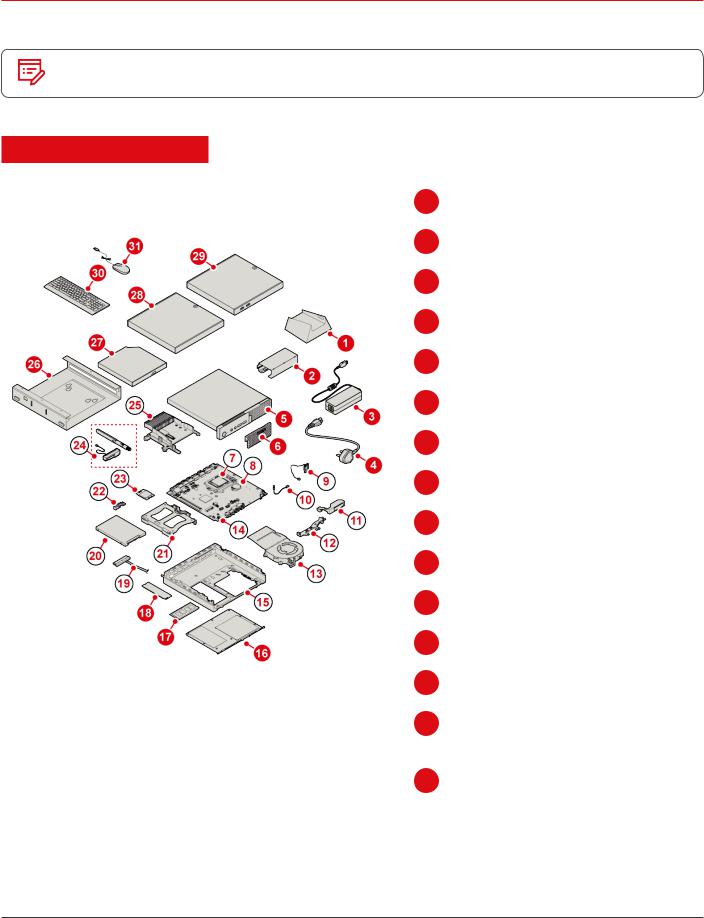
CRUs and FRUs locations
Refer to the following illustrations to check the locations of CRUs and FRUs within the computer.
Note |
Some of the following parts are optional on some models. |
Self-service CRU
1 |
Vertical stand |
|
|
|
|
|
|
|
|
|
|
|
|
|
|
|
|
|
|
|
|
|
|
|
|
|
|
||||
p. 23 |
|||||||||||||||||||||||||||||||
|
|
|
|
|
|
|
|
|
|
|
|
|
|
|
|
|
|
|
|
|
|
|
|
|
|
|
|
|
|
|
|
2 |
Power adapter bracket |
|
|
|
|
|
|
|
|
||||||||||||||||||||||
p. 27 |
|||||||||||||||||||||||||||||||
|
|
|
|
|
|
|
|
|
|
|
|
|
|
|
|
|
|
|
|
|
|
|
|
|
|
|
|
|
|
|
|
3 |
Power adapter |
|
|
|
|
|
|
|
|
|
|
|
|
|
|
|
|
|
|
|
|
|
|||||||||
p. 22 |
|||||||||||||||||||||||||||||||
|
|
|
|
|
|
|
|
|
|
|
|
|
|
|
|
|
|
|
|
|
|
|
|
|
|
|
|
|
|
|
|
4 |
Power cord |
|
|
|
|
|
|
|
|
|
|
|
|
|
|
|
|
|
|
|
|
|
|
||||||||
p. 22 |
|||||||||||||||||||||||||||||||
|
|
|
|
|
|
|
|
|
|
|
|
|
|
|
|
|
|
|
|
|
|
|
|
|
|
|
|
|
|
|
|
5 |
Computer cover |
|
|
|
|
|
|
|
|
|
|
|
|
|
|
|
|
|
|
||||||||||||
p. 28 |
|||||||||||||||||||||||||||||||
|
|
|
|
|
|
|
|
|
|
|
|
|
|
|
|
|
|
|
|
|
|
|
|
|
|
|
|
|
|
|
|
6 |
Dust shield |
|
|
|
|
|
|
|
|
|
|
|
|
|
|
|
|
|
|
|
|||||||||||
p. 28 |
|||||||||||||||||||||||||||||||
|
|
|
|
|
|
|
|
|
|
|
|
|
|
|
|
|
|
|
|
|
|
|
|
|
|
|
|
|
|
|
|
16 |
Bottom cover |
|
|
|
|
|
|
|
|
|
|
|
|
|
|
|
|
|
|||||||||||||
p. 35 |
|||||||||||||||||||||||||||||||
|
|
|
|
|
|
|
|
|
|
|
|
|
|
|
|
|
|
|
|
|
|
|
|
|
|
|
|
|
|
|
|
17 |
Memory module |
|
|
|
|
|
|
|
|
|
|
|
|
|
|||||||||||||||||
p. 36 |
|||||||||||||||||||||||||||||||
|
|
|
|
|
|
|
|
|
|
|
|
|
|
|
|
|
|
|
|
|
|
|
|
|
|
|
|
|
|
|
|
18 |
M.2 storage drive |
|
|
|
|
|
|
|
|
|
|
|
|||||||||||||||||||
p. 37 |
|||||||||||||||||||||||||||||||
|
|
|
|
|
|
|
|
|
|
|
|
|
|
|
|
|
|
|
|
|
|
|
|
|
|
|
|
|
|
|
|
26 |
VESA® mount bracket |
|
|
|
|
|
|
|
|||||||||||||||||||||||
p. 24 |
|||||||||||||||||||||||||||||||
|
|
|
|
|
|
|
|
|
|
|
|
|
|
|
|
|
|
|
|
|
|
|
|
|
|
|
|
|
|
|
|
27 |
External optical drive |
|
|
|
|
|
|
||||||||||||||||||||||||
p. 25 |
|||||||||||||||||||||||||||||||
|
|
|
|
|
|
|
|
|
|
|
|
|
|
|
|
|
|
|
|
|
|
|
|
|
|
|
|
|
|
|
|
28 |
External optical drive box |
|
|
|
|
||||||||||||||||||||||||||
p. 25 |
|||||||||||||||||||||||||||||||
|
|
|
|
|
|
|
|
|
|
|
|
|
|
|
|
|
|
|
|
|
|
|
|
|
|
|
|
|
|
|
|
29 |
External I/O box |
|
|
|
|
||||||||||||||||||||||||||
p. 26 |
|||||||||||||||||||||||||||||||
|
|
|
|
|
|
|
|
|
|
|
|
|
|
|
|
|
|
|
|
|
|
|
|
|
|
|
|
|
|
|
|
30 |
Keyboard or wireless |
||||||||||||||||||||||||||||||
|
keyboard |
|
|
|
|
||||||||||||||||||||||||||
|
p. 19 |
||||||||||||||||||||||||||||||
|
|
|
|
|
|
|
|
|
|
|
|
|
|
|
|
|
|
|
|
|
|
|
|
|
|
|
|
|
|
|
|
31 |
Mouse or wireless mouse |
|
|
||||||||||||||||||||||||||||
p. 20 |
|||||||||||||||||||||||||||||||
|
|
|
|
|
|
|
|
|
|
|
|
|
|
|
|
|
|
|
|
|
|
|
|
|
|
|
|
|
|
|
|
Replacing hardware |
14 |
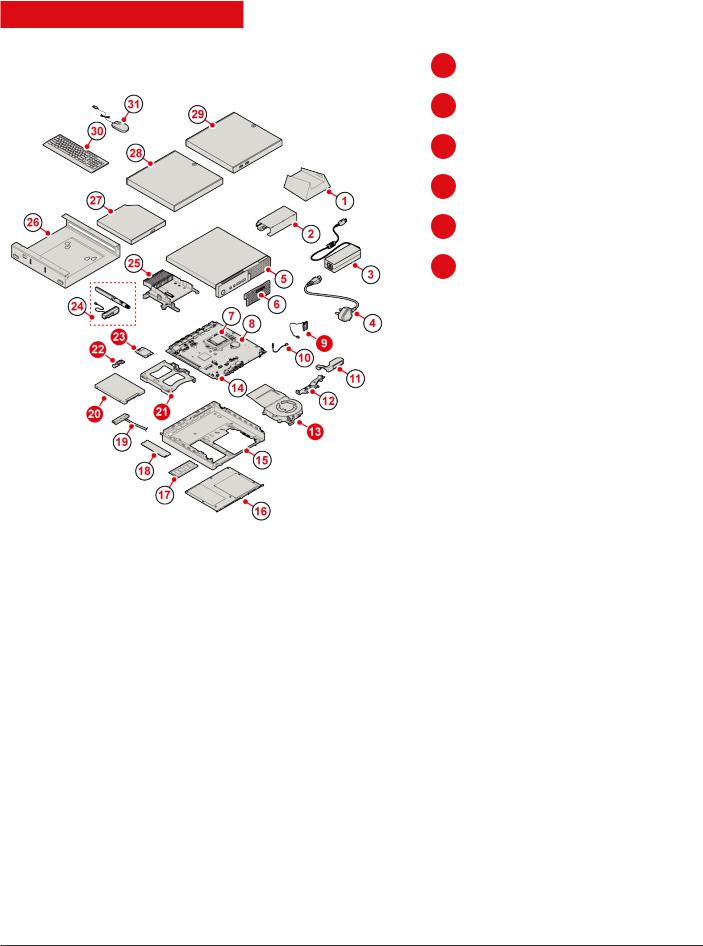
Optional-service CRU
9 |
Internal speaker |
|
|
|
|
|
|
|
|||||
p. 30 |
|||||||||||||
|
|
|
|
|
|
|
|
|
|
|
|
|
|
13 |
System fan |
|
|
|
|
|
|
|
|
|
|||
p. 31 |
|||||||||||||
|
|
|
|
|
|
|
|
|
|
|
|
|
|
20 |
Storage drive |
|
|
|
|
|
|
|
|||||
p. 29 |
|||||||||||||
|
|
|
|
|
|
|
|
|
|
|
|
|
|
21 |
Storage drive bracket |
|
|
|
|||||||||
p. 29 |
|||||||||||||
|
|
|
|
|
|
|
|
|
|
|
|
|
|
22 |
Wi-Fi card shield |
|
|
||||||||||
p. 32 |
|||||||||||||
|
|
|
|
|
|
|
|
|
|
|
|
|
|
23 |
Wi-Fi card |
|
|
||||||||||
p. 32 |
|||||||||||||
|
|
|
|
|
|
|
|
|
|
|
|
|
|
Replacing hardware |
15 |
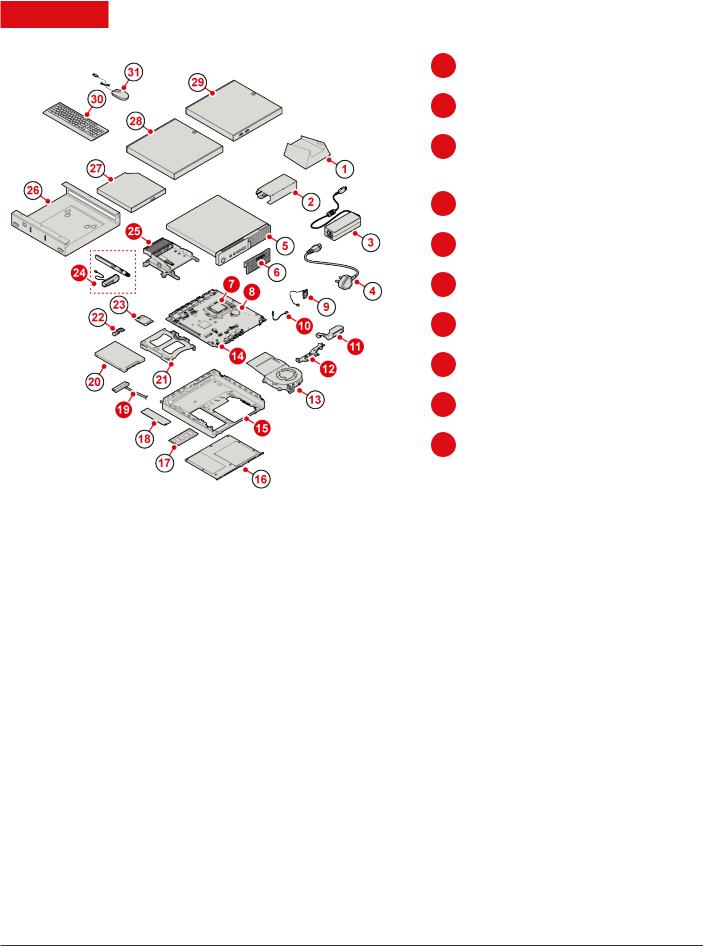
FRU
7 |
Microprocessor |
|
|
|
|
|
|
|
|
|
|
|
|
|||||||
p. 48 |
||||||||||||||||||||
|
|
|
|
|
|
|
|
|
|
|
|
|
|
|
|
|
|
|
|
|
8 |
Coin-cell battery |
|
|
|
|
|
|
|
|
|
||||||||||
p. 50 |
||||||||||||||||||||
|
|
|
|
|
|
|
|
|
|
|
|
|
|
|
|
|
|
|
|
|
10 |
Illuminated red dot cable |
|||||||||||||||||||
|
|
|
|
|
|
|
|
|
|
|
|
|
|
|
|
|
||||
|
p. 41 |
|||||||||||||||||||
|
|
|
|
|
|
|
|
|
|
|
|
|
|
|
|
|
|
|
|
|
11 |
Advanced speaker |
|
|
|
|
|
|
|
||||||||||||
p. 42 |
||||||||||||||||||||
|
|
|
|
|
|
|
|
|
|
|
|
|
|
|
|
|
|
|
|
|
12 |
Antenna bracket |
|
|
|
|
|
|
|||||||||||||
p. 52 |
||||||||||||||||||||
|
|
|
|
|
|
|
|
|
|
|
|
|
|
|
|
|
|
|
|
|
14 |
System board |
|
|
|
|
|
|
|
||||||||||||
p. 52 |
||||||||||||||||||||
|
|
|
|
|
|
|
|
|
|
|
|
|
|
|
|
|
|
|
|
|
15 |
Chassis |
|
|
|
|
|
|
|
|
|||||||||||
p. 52 |
||||||||||||||||||||
|
|
|
|
|
|
|
|
|
|
|
|
|
|
|
|
|
|
|
|
|
19 |
Storage drive cable |
|
|
|
||||||||||||||||
p. 46 |
||||||||||||||||||||
|
|
|
|
|
|
|
|
|
|
|
|
|
|
|
|
|
|
|
|
|
24 |
Wi-Fi antennas |
|
|
|||||||||||||||||
p. 43 |
||||||||||||||||||||
|
|
|
|
|
|
|
|
|
|
|
|
|
|
|
|
|
|
|
|
|
25 |
Heat sink |
|
|
|||||||||||||||||
p. 47 |
||||||||||||||||||||
|
|
|
|
|
|
|
|
|
|
|
|
|
|
|
|
|
|
|
|
|
Replacing hardware |
16 |

Replacing CRUs
Before replacing CRUs
Customer Replaceable Units (CRUs) are computer parts that a user can upgrade or replace. There are two types of CRUs: self-service and optional-service.
To check the locations of CRUs, see CRUs and FRUs locations.
 Attention
Attention
Do not open your computer or attempt any repairs before reading the Important Product Information Guide.
Before replacing a CRU, click the illustration of the part to check the brief procedures.
Keyboard or wireless |
Mouse or wireless |
Power adapter |
keyboard |
mouse |
|
Vertical stand |
VESA mount bracket |
External optical drive |
Replacing CRUs |
17 |
